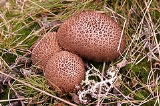
Lycoperdon umbrinum
Encyclopedia
Lycoperdon umbrinum, commonly known as the umber-brown puffball, is a type of Puffball
mushroom in the genus Lycoperdon
. It is found in China,, Europe, and North America.
. It is 2 to 5 cm (0.78740157480315 to 2 in) tall and 1 to 4 cm (0.393700787401575 to 1.6 in) broad. The fruiting body is initially pale brown then reddish to blackish brown, and the outer wall has slender, persistent spines up to 1 mm long. Spore
s are roughly spherical, 3.5–5.5 µm in diameter, with fine warts and a pedicel that is 0.5–15 µm long. It is uncommon and found mostly in coniferous woods on sandy soils.
Puffball
A puffball is a member of any of several groups of fungus in the division Basidiomycota. The puffballs were previously treated as a taxonomic group called the Gasteromycetes or Gasteromycetidae, but they are now known to be a polyphyletic assemblage. The distinguishing feature of all puffballs is...
mushroom in the genus Lycoperdon
Lycoperdon
Lycoperdon is a genus of puffball mushrooms. The genus has a widespread distribution and contains about 50 species. In general, it contains the smaller species such as the pear shaped puffball and the gem studded puffball. Most of the time they grow from dead wood and if they grow through the...
. It is found in China,, Europe, and North America.
Description
This species has a fruiting body that is shaped like a top or a pear, with a short, partly buried stipeStipe (mycology)
thumb|150px|right|Diagram of a [[basidiomycete]] stipe with an [[annulus |annulus]] and [[volva |volva]]In mycology a stipe refers to the stem or stalk-like feature supporting the cap of a mushroom. Like all tissues of the mushroom other than the hymenium, the stipe is composed of sterile hyphal...
. It is 2 to 5 cm (0.78740157480315 to 2 in) tall and 1 to 4 cm (0.393700787401575 to 1.6 in) broad. The fruiting body is initially pale brown then reddish to blackish brown, and the outer wall has slender, persistent spines up to 1 mm long. Spore
Spore
In biology, a spore is a reproductive structure that is adapted for dispersal and surviving for extended periods of time in unfavorable conditions. Spores form part of the life cycles of many bacteria, plants, algae, fungi and some protozoa. According to scientist Dr...
s are roughly spherical, 3.5–5.5 µm in diameter, with fine warts and a pedicel that is 0.5–15 µm long. It is uncommon and found mostly in coniferous woods on sandy soils.

